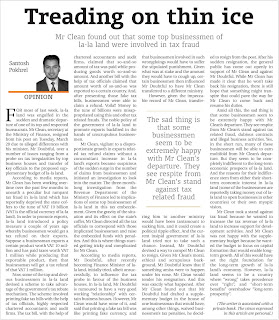The US almost came to a standstill on April 8, 2011. The Republicans, who control the House of Representatives, and the Democrats, who control the Senate, locked horns over differences on US President Barack Obama’s proposed budget. The dispute threatened to lead the US into a government shutdown which would have resulted in the closure of all government related activities from museums to metros to municipal parks. Disenchanted with the Democrats’ profligacy, the Republicans have been demanding huge spending cuts especially on social security benefits and environmental protection, causes which are strongly espoused by the Democrats, to rein in the budget deficit which has spiralled out of proportion especially during the last few years.
During these last few years, the Democrats had some form of monopoly over public policy decisions. President Obama is a Democrat, and his party had control over both the Senate and the House in 2009 and 2010. As such, the Republicans blame the Democrats and their spending habits for causing the US deficit to rise to historic proportions. Using the core Republican values of limited government and less tax and criticising the Democrats’ spending policies, the Republicans made significant gains during the midterm election of 2010, and wrested the House from Democratic control. Given the public’s mandate through the ballot and the control over the House, the Republicans have recently been more vociferous regarding US deficit levels and the need to control spending.
While the Democrats and the Republicans were able to reach a deal in the last hour of April 8 and stop a government shutdown besides avoiding an embarrassing situation, the current level of the US deficit and the state of the US economy pose unique and hitherto untackled challenges. According to the International Monetary Fund’s (IMF) recent publication entitled “Fiscal Monitor”, the US is expected to have the largest budget deficit (as a percentage of the GDP) among the major developed countries in 2011. The figure of 10.8 percent quoted by the IMF is higher than that of other deficit-prone developed economies such as the UK and Japan.
In economics literature, a budget deficit of over 5 percent for a prolonged period of time can have adverse consequences as higher government borrowing pushes up the economy’s interest rate and, as a result, “crowds out” investment hurting the economy. The US has been facing a severe budget deficit for the last couple of years.
Despite the high budget deficit, US interest rates have not reached unmanageable levels. Some economists such as Paul Krugman, a devout Democrat, have been using the low yields on US Treasury bonds to argue that the current deficit doesn’t pose a long-term economic challenge. The low yield on US Treasury bonds, however, has been largely attributed to the financial crisis of 2008. After the financial crisis, investors sought the safety of US Treasuries over other riskier assets which have helped to keep the yields on these bonds low and also helped the US government finance its borrowing at a lower cost.
In the past, the US has been able to ride out high-deficit situations with a subsequent economic turnaround. During his first presidential term, Bill Clinton had similar woes of high deficit. But the US economy turned around quickly and robustly, and the deficit was replaced by a massive surplus by the end of his term in 2000.
This time, it’s a bit different. Although the US economy has been technically out of the recession of 2008, high unemployment and meagre economic growth have dampened tax receipts of the US government. Moreover, entitlement spending for the unemployed and other spending programmes to stimulate the economy have pushed up government spending. As a result, the deficit has grown year after year and debt has been piling up.
According to the latest figures, the total US debt now stands at approximately US$ 14.2 trillion (around 95 percent of the total GDP) and it is soon expected to surpass 100 percent. (This can help contextualise the current level of US debt: Among the PIGS group of countries, only Greece has a debt to GDP ratio in excess of 100 percent)
As a result, many people are spooked by the current US debt level and where it is heading. Bill Gross, legendary bond investor and chairman of the world’s biggest fixed income management company at Pacific Investment Management Company (PIMCO), thinks that the unrecorded US debt level is close to US$ 75 trillion (if one accounts for future obligations such as Medicare, Medicaid and other social security benefits).
Gross believes that this will definitely lead to higher inflation, a higher interest rate and a lower US dollar. As a result, PIMCO has been moving out of US Treasuries. Not only that, PIMCO has now started to sell short US Treasuries. Others are following suit, and many are now shorting the US Treasuries linked Exchange Traded Funds (ETFs).
Him and others, who have a pessimistic view of US debt, have the rationale that when the US Federal Reserve quantitative easing ends in June, US Treasuries will sink as the excess liquidity moves out of the system. Warren Buffet once advised, “Never short the United States.” In the past, the US has always come out of adversities stronger — from the Cuban missile crisis to the Cold War to Japan’s economic ascent. We have to wait and see how it plays out this time.
This was first published in the Kathmandu Post on April 18 2011. Permanent Link:
http://www.ekantipur.com/the-kathmandu-post/2011/04/17/money/us-on-razors-edge/220722.html
Monday, April 18, 2011
Thursday, April 7, 2011
Subscribe to:
Posts (Atom)
